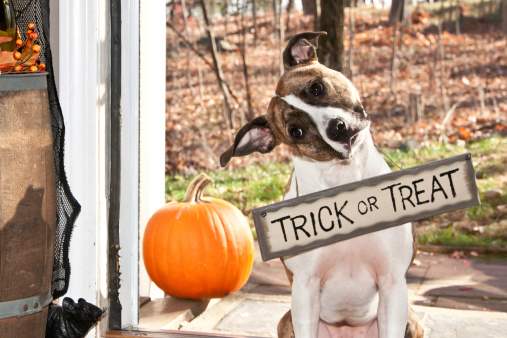This post was originally published a few years ago but the information continues to be important in light of the weekend festivities. Have a wonderful Halloween!
Every Halloween (and on several other holidays, for that matter) we see pets show up at the Ann Arbor Animal Hospital who are sick from ingesting candy, so we thought we would post some information that may help you let kids know about the effects of candy and other sweets and their potential to harm your pet.
Hospital who are sick from ingesting candy, so we thought we would post some information that may help you let kids know about the effects of candy and other sweets and their potential to harm your pet.
Chocolate
In addition to high fat content, chocolate contains stimulants (caffeine and theobromine) that affect the central nervous system and the heart muscle, as well as increase the frequency of urination. If your 50-pound dog eats a chocolate-chip cookie, it probably won’t cause him serious problems. However, if he gobbles up a pan of brownies or a few candy bars he may develop vomiting or diarrhea.
The amount of chocolate that it takes to poison your pet depends on the type of chocolate he’s eaten and his weight. The darker the chocolate, the more toxic it is for pets. Once toxic levels are reached, the stimulants kick in, and this is when you really have to worry.
Symptoms
• restlessness
• hyperactivity
• muscle twitching
• increased urination
• excessive panting
• seizures
Even if your pet doesn’t eat enough chocolate to induce toxicity, the candy’s high fat content may cause him to vomit or have diarrhea. If that happens, call your veterinarian (call sooner if your pet is very small or young). Aside from toxicity issues, you don’t want your pet to dehydrate. When you call the vet, try to be as precise as you can about the type of chocolate and how much the animal ate, and when he ate it (approximately). The sooner you get help, the better off your pet will be. The animal has a better chance of recovery if he is treated immediately and is less like to have further clinical signs if treated immediately after ingestion. However, the effects of the chocolate can linger for 12 to 36 hours, so your pet may require hospitalization.
The danger of xylitol when ingested by pets (potentially more deadly than chocolate!)
Xylitol, also called wood sugar or birch sugar, is a five-carbon sugar alcohol that is used as a sugar substitute. It can be extracted from birch, raspberries, plums and corn and is primarily produced in China. It’s found in sugar-free gum and candy, and many people use it for baking cakes, cookies, etc.; it’s also found in many low-carb products.
While it’s completely non-toxic to humans, it is very toxic to dogs and cats. This can be a hidden danger as, though many people know not to feed dogs chocolate, they may think it’s okay to give their dog a sugar-free treat like a cookie from time to time.
Effects of xylitol ingestion
In both humans and animals, the levels of blood sugar are controlled by the body’s release of insulin from the pancreas. In dogs and cats, xylitol causes a fast release of insulin, which results in a rapid decrease in blood glucose (hypoglycemia) which can be very dangerous. Just a few pieces of gum containing xylitol can be fatal for a small dog or cat.
Symptoms
Clinical signs of xylitol toxicity can develop in as few as 30 minutes after ingestion. They may include one or more of the following:
• Vomiting
• Weakness
• Ataxia (uncoordinated movements)
• Depression
• Hypokalemia (decreased potassium)
• Seizures
• Coma
• Liver distress and/or failure
Treatment
After ingesting xylitol, a dog or cat may receive one of more of the following treatments, depending on the amount of time that has lapsed since the ingestion occurred. The induction of vomiting is recommended if performed very soon after ingestion of the xylitol-containing product but before clinical signs develop. Frequent small meals or an oral sugar supplement may be used to manage animals that have not yet shown clinical signs. Once the symptoms have manifested themselves, intravenous dextrose can be used to control hypoglycemia. It may also be necessary to treat the patient for low potassium levels (hypokalemia). Treatment should be administered until the blood glucose levels return to normal levels. Bloodwork and liver values must also be monitored.
Ann Arbor Animal Hospital recommends that pet owners seek medical attention rather than putting if off. While certain home remedies (peroxide) have been suggested on websites or even from vet phone consults, we believe it is better to be safe than sorry if your pet has ingested chocolate or xylitol.
Other poison-related resources are posted on the ASPCA Animal Poison Control website.
More dangers (including raisins, glowsticks, candy wrappers, etc.) listed on DVM360.
Now that we have that out of the way, Happy Halloween!
Thanks to Jennifer Dec, DVM, for her help with this article.
Recent Posts
About Us
Ann Arbor Animal Hospital is a locally-owned animal hospital operating for over 90 years in Ann Arbor, MI.

